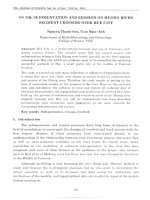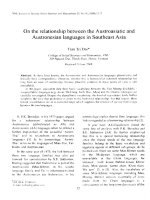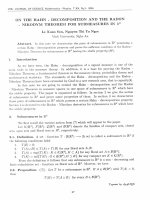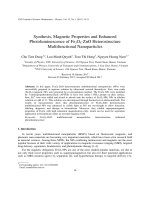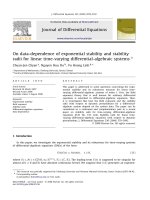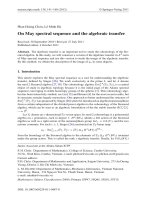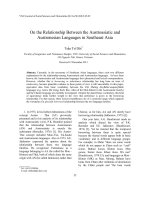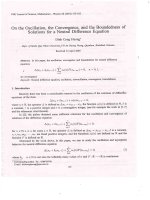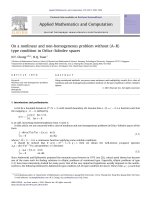DSpace at VNU: On pseudo-open s-images and perfect images of frechet ditarily determined spaces
Bạn đang xem bản rút gọn của tài liệu. Xem và tải ngay bản đầy đủ của tài liệu tại đây (3.27 MB, 8 trang )
V N U . J O U R N A L O F S C IE N C E , M a th e m a tic s - Physics. T .X X II, N 0 2 - 2 0 0 6
ON P S E U D O -O P E N 5 -IM A G E S A N D P E R F E C T IM A G E S OF
F R E C H E T H E R E D IT A R IL Y D E T E R M I N E D SPACES
T ra n V a n A n
Faculty o f M athem atics, V inh University
T hai D oan C huong
Faculty o f M athematics, Dong Thap Pedagogical In stitu te
A bstract . In this paper we prove a mapping theorem on Frechet spaces with a locally
countable k-network and give a partial answer for the question posed by G. Gruenhage,
E. Michael and Y. Tanaka.
1. I n tr o d u c tio n
Let X be a topological space, and p b e a cover of X . We say th a t X is determined
by V , or V determines X , if u c X is open (closed) in X if and only if u n p is relatively
open (respectively, closed) in p for every p e V .
V
K c
is a k-network, if whenever K c
u
w ith K com pact and
u
open in X , then
c u for a certain finite collection T c V . V is a network, if X £ u w ith u open
in X , then X G p c u for some P g P .
A collection V of subsets of X is star-countable (respectively, point-countable) , if
every p e V (respectively, single point) meets only countable m any members oỉ V . A
collection V of subsets of X is locally countable, if every X e X there is a neighborhood V
of X such th a t V m eets only countable many members of V .
Note th a t every star-countable collection or every locally countable collection is
point-countable.
A space X is a sequential space, if evsry A c X is closed in X if and only if no
sequence in A converges to a point not in A.
A space X is Préchet, if for every A c X and X e à there is a sequence { x n } c A
such th a t x n —>X.
A space X is a k-space, if every Ẩ c I
is closed in X if and only if A n K is
relatively closed in X for every compact K c X .
A space X is a Ơ-space if it has a a-locally finite network.
A space X has countable tightness (abbrev. t ( X ) < a;), if, whenever £
then X G c for some countable c c A.
Typeset by
1
£ AinX ,
Tran Van A n , T h a i D oan C h u o n g
2
A space X is a countably bi-k-space if, whenever (A n) is a decreasing sequence of
subsets of X with a common cluster point X, then there exists a decreasing sequence (B n )
of subsets of X such th a t X £ (An n B n) for all n e N, the set K = P i Bn is com pact,
neN
and each open u containing K contains some B n .
Note th a t every Frechet space is a sequential space and every sequential Hausdorff
space is a /c-space, every sequential space has countable tightness, locally compact spaces
and first countable spaces are countably bi-/c-space, and every countably bi-fc-space is a
fc-space.
We say th at a m ap / : X —> Y is perfect if / is a closed m ap and
is a com pact
subspace of X for every y G Y . A map / : X -* Y is pseudo-open if, for each y e y ,
y £ I n t/( ơ ) whenever u is an open subset of X containing / _ 1 (y). A map f : X - ì Y is
Lindelof if every
is Lindelof. A map f : X -ỳ Y is a s-m ap if f ~ 1 {y) is separable for
each y e Y . A map f : X -¥ Y is compact-covering if every compact i f c y is an image
of a compact subset c c X . A map f : X
Y is compact-covering if every compact
AT c y is an image of a com pact subset c c X . A map f : X
Y is sequence-covering
if every convergent sequence (including its limit) 5 c y is an image of a com pact subset
c ex.
Note th a t every closed m ap or every open m ap is pseudo-open, every pseudo-open
map is quotient, and if / : X -» Y is a quotient m ap from X onto a Frechet space
y , then / is pseudo-open. Every compact-covering map is sequence-covering, and every
sequence-covering m ap onto a Hausdorff sequential space is quotient.
In [3] G. Gruenhage, E. Michael and Y. Tanaka raised the following question
Q u e s tio n . Is a Frechet space having a point-countable cover V such th a t each open
u c X is determ ined by { p € V : p c u } preserved by pseudo-open s-m aps or perfect
maps?
In [5] S. Lin and c . Liu gave a partial answer for the above question.
In this paper we prove a m apping theorem on Frechet spaces with a locally countable
fc-network and give an another partial answer for the above question.
We assume t h a t ‘spaces are regular Ti, and all maps are continuous and onto.
2. P re lim in a rie s
For a cover V of X , we consider the following conditions (A) - (E), which are labelled
(1.1) - (1.6), respectively in [3].
on p seu d o -o p en s-im a g es a nd p erfect im ages o f ...
3
(A) X has a point-countable cover V such th at every open set u c X determined
by { P e V : P c i / } .
(B) X has a point-countable cover V such th at if X E u with u open in X , then
X e ( u T )° c U F c u for some finite subfamily T of V.
(B)p
in X ,
X has a point-countable cover V such th at if X £ X \ {p} with p is a point
then X € (Lơ 7)0 c U T c X \ {p} for some finite subfamily T of V.
(C) X has a point-countable cover V such th at every open set u c X determined
by collection
{ P € V : p c u }* , where u* = {U.?7 : T is a finite subfamily of u } .
(C)p
X has a point-countable cover V such th a t for every point p € X ,
the set
X \ {p} determined by collection {P e V : p c (X \ {p})}*.
(D) X has a point-countable k-network.
(D)p X has a point-countable fc-network V such th a t if K is compact and K c
X \ {p}, then K c U T c X \ {p} for some finite subfamily T of V .
(E) X has a point-countable closed /u-network.
Now we recall some results which will be used in the sequel
L e m m a 2.1 ([1[).
The following properties o f a space X are equivalent
(i) X has a point-countable base;
(ii) X is a k-space satisfying (B);
(in) t ( X ) ^ U) and X satisfies (B).
L e m m a 2.2 ([3]). For a space X , we have the follow ng diagram
(B)
=>
w
CỈ
( 2)
(A)<=fjj
(Q
( 2)
=»
(Qp
w (3)
f (3t )
(D)
(B)
=>
(D)p.
(1) A cover V of X is closed,
(2) X is a countably bi-/c-space, (3) X is a fc-space
L e m m a 2.3 ([9[). E very k-space with a star-countable k-network is a paracompact Ơspace.
L e m m a 2.4 ([2]). E very separable paracompact space is a Lindelof space.
Tran Van A n , T h a i D oan C huong
4
L e m m a 2.5 ([7]).
I f f : X -> Y is a pseudo-open m ap, and X is a Frechet space, then
so is Y .
L e m m a 2.6 ([3]).
For a space X the following statem ents are equivalent
(a)
X is a sequence-covering quotient s-image o f a metric space;
(b)
X is a quotient S’image o f a m etric spaceỊ
(c)
X is a k-space satisfying (A).
R e m a rk 2.7. We write
X is a fc-space satisfying (E);
(d)
(e) X is a compact-covering quotient s-image of a m etric space.
Then we have (d) => [(a) <=> (b) <=> (c)] , (e) => [(a)
(b) & (c)], and (d) => (e)
hold.
L e m m a 2.8 ([3]). Suppose that X is a space satisfying (D) and f : X —> Y is a map.
Then either (i) or (a) implies that Y is a space satisfying (D).
(i) f is a quotient s-m ap and X is a FYechet spaceỊ
(a) f is a perfect map.
L e m m a 2.9 ([4]). Let X be a Frechet space. Then the following statem ents are equivalent
(i)
X has a star-countable closed k-network;
(a) X has a locally countable k-network;
(in) X has a point-countable separable closed k-network;
(iv) X is a locally separable space satisfying (D);
(v) X has a ơ-locally finite closed Lindelof k-network.
3. T h e m a in R e s u lts
L e m m a 3.1.
Let X be a space having a locally countable k-network. Then for every
X G X there is a Lindelof neighborhood V o f X.
Proof. Let V be a locally countable k-network for X . For X G X there is an open
neighbourhood V of X such th a t V meets only countable many elements of V . Denote
V x = {P G V : p c V’}. Then V x is countable and V = u { p : p G Vx). Let u be an
any open cover of V. For y 6 V there exists ư G w such th at y E u . Since V is a locally
countable k-network for X , there is p G V satisfying y G p c ư n V. For P g ? i put a
on p seu d o -o p en s-im a g e s a nd p erfect im ages o f ...
5
Up GW such th a t p c Up. Since Vx is countable and V = u { p : p £ V x }, it implies th at
the family Ux = {Up
: p G Vx ) is a countable cover of X . Hence, V is Lindelof.
Let X be a Frechet space having a locally countable k-network. Then the
L e m m a 3.2.
following conditions are equivalent
(i) f : X —» Y is a Lindelof map;
(ii) f : X —>Y is a s-map.
Proof,
(i) => (ii). Suppose th at / : X -» Y is a Lindelof map, and X is a Frechet
space having a locally countable /^-network V . For every y 6 y , put any z G / _ 1 (y),
by Lem ma 3.1 there is an open Lindelof neighborhood v z of 2 such th at v z m eets only
countably many elements of V . The family {Vz : z G f ~ 1 {y)} is an open cover of / _ 1 (y).
Because f ~ l (y) is Lindelof, there exists a countable family {VZk : k > 1} covering f ~ 1 (y)
for every y (z Y . P u ttin g u =
VZk we have f ~ 1 {y) c Í/, and Q = {P G ? : p c (/}
fc=i
is countable. Then it is easy to show th at Q is a count able-network in u . Because every
space with a countable-network is hereditarily separable and f ~ 1 (y) c Í/, it follows th at
/ - 1 (j/) separable. Thus / is a s-map.
(ii)
=> (i). Suppose th a t / : X —>Y is a 5-m ap, and X is a Frechet space having a
locally countable A;-network. As well-known th a t every Frechet space is a k-space. Then
by Lem ma 2.9 and Lem m a 2.3, X is a paracom pact ơ-space. Since / is continuous, for
every y € Y , we have f ~ 1 (y) is closed, it implies th a t / _ 1 (y) is a paracom pact subspace
of X . Because / is a s-m ap, by Lemma 2.4, it follows th a t f ~ 1 {y) is Lindelof. Hence / is
a Lindelof map.
L e m m a 3.3.
L et f : X —> y be a pseudo-open Lindelof m ap (or a pseudo-open s-map,
or a perfect map), and X a Frechet space having a locally countable k-network. Then Y
is a locally separable space.
Proof. Let f : X
Y be a pseudo-open Lindelof map, and X a Frechet space having
a locally countable k-network. By Lemma 2.9 it implies th a t X is a locally separable space.
For every y € Y , we take 2 G / _ 1 (y). Since X is a locally separable space, there exists
an open neighborhood Vz of z such th a t Vz is separable. The family {Vz : z £ f ~ l (y)}
is an open cover of / _ 1 (y). Because f ~ l (y) is Lindelof, there exists a countable family
oo
{Vzk ■ k > 1} covering / _1(y). Denoting u =
IK
we have / l (y) c u and u is
fc=i
separable. Because / is continuous, it implies th at f ( U ) is a separable subset of Y . Since
/ is pseudo-open, we get y G Int/({7). Thus, / ( t / ) is a separable neighborhood of y, and
y is a locally separable space.
Tran Van A n , T h ai D o a n C h u o n g
6
Because every perfect m ap is pseudo-open Lindelof and it follows from Lem m a 3.2
th at the theorem is true for a pseudoopen s-map, or a perfect map.
T h e o r e m 3 .4 .
For a k-space X we have
(i) (E ) => (A) holds;
(ii) T he converse implication is true i f X is a locally separable Frechet space.
Proof. Firstly we shall prove the first assertion. Suppose X is a k-space, and V is a
point-countable closed k-network for X satisfying (E), then we shall prove th a t V satisfies
(A). Let u be open in X , and let A c Ư such th a t A n p is closed in p for every p G p
with p c Ơ, and suppose th a t A is not closed in u . T hen because u is open in X , u is
a k-space, so we have A n Ko is not closed in Kq for some compact Ko c u . Since V is a
fc-network for X , there exists a finite T c V such th a t Ko c L)T c u . On the other hand,
cover V is closed. This implies th a t there exists a p € J 7 such th at A n p is not closed in
P. This is a contradiction. Hence we have (A), and (E ) => (A) holds.
We now prove the second assertion. Suppose X is a locally separable Frechet space
satisfying (A). Since X satisfies (A), it follows from Lemma 2.2 th at X satisfies (D). By
Lemma 2.9 it implies th a t X satisfies (E).
By Lem m a 2.1, Lemma 2.2,Lemma 2.9 and Theorem 3.4, we obtain th e following
C o ro lla ry
3 .5 . For a space X ,wehave the following diagram
(A)
< = (4 )
(B)
=»
(B)p
M
if
( 2)
( E ) < = ( 5)
(A)
(3
< = (1 )
^
(A)
(C)
( 2)
=>
(C)p
I (3)
t
(3)
(D)
=>
(D)p.
( 1 ) A cover V of X is closed or X is a countably bi-A;-space,
(2) X is a countably bi-fc-spgtce, (3) X is a /c-space,
(4) X is a k-space, or t ( X ) ^ (J, (5) X is a locally separable Frechet space
By Rem ark 2.7, Lemma 2.9, and using the proof presented in (ii) of Theorem 3.4
we obtain the following
C o ro lla ry 3 .6 . Let X be a locally separable Frechet space. Then the following statem ents
are equivalent
(a) X is a sequence-covering quotient s-image o f a m etric spaceỊ
(b) X is a quotient s-image o f a m etric space;
on p seu d o -o p en s-im a g es a nd p erfect im ages o f...
(c)
X is a space satisfying (A);
(d)
X is a space satisfying (E);
7
(e) X is a compact-covering quotient s-image o f a m etric space.
(f) X has a star-countable closed k-network;
(g) X has a locally countable k-network;
(h) X has a point-countable separable closed k-network;
(k) X is a space satisfying (D);
(I) X has a Ơ-locally finite closed Lindelof k-network.
We now have a m apping theorem for Préchet spaces having a locally countable
fc-network
T h eo re m
3 .7 .
L et f : X -> Y be a pseudo-open Lindelof m ap (or a pseudo-open s-map,
or aperfect map). I f X is a Frechet space having a locally countable k-network,
then so
does Y .
Proof. Because every perfect map is a pseudo-open Lindelof map, and X is a Frechet
space having a locally countable fc-network, by Lemma 3.2 we suppose th a t / : X —►Y is a
pseudo-open s-m ap. Since X is Frechet, and / is pseudo-open, it follows from Lemma 2.5
th at Y is a Frechet space. Because every locally countable /c-network is a point-countable
/c-network, and every pseudo-open map is quotient, by Lem ma 2.8(i) we get th a t Y has a
point-countable k-network.
From Lem m a 3.3 it follows th a t Y is a locally separable space. Hence, Y is a locally
separable Frechet space satisfying (D). By Corollary 3.6, it implies th a t Y has a locally
countable /c-network.
From the above theorem we obtain the following corollary
C o ro lla ry 3 .8 .
L et f : X -> Y be a pseudo-open Lindelofm ap (or a pseudo-open s-map,
or a perfect m ap). I f X is a Frechet space satisfying one o f the following, then so doing
Y, respectively.
(a) X has a locally countable k-network;
(b) X has a star-countable closed k-network;
(c) X is a locally separable space satisfying (D);
(d) X has a Ơ-locally finite closed Lindelof k-network;
(e) X has a point-countable separable closed k-network.
D e fin itio n 3 .9 .
A space X is called a FYechet hereditarily determined, space (abbrev.
F H D -space), if X is Frechet and satisfies (A).
Tran Van A n , T h a i D o a n C h u o n g
8
R e m a rk ,
(i) Every m etric space is a F H D - space.
(ii) Every subspace of a F H D -space is a F H D - space.
(iii) If X is a F H D - space, and if / : X -» Y is an open s-m ap or a pseudo-open
map with countable fibers, then so is Y.
Now we give a partial answer for the question in §1.
T h e o re m 3 .1 0 .
I f X is a locally separable FHD-space, and f : X —» Y is a pseudo-open
Lindelof map (or a pseudo-open s-m ap , or a perfect map), then Y is a locally separable
F H D-space.
Proof. Because every perfect map is pseudo-open Lindelof 5-m ap, we can suppose
th at X is a F H D -space and / : X —» Y is a pseudo-open 5-map or a pseudo-open Lindelof
map. Since X is Frechet, and / : X -» Y is a pseudoopen map, it follows from Lem ma
2.5 th at Y is Frechet. On the other hand, since X is a Frechet space satisfying (A), by
Corollary 3.6 it implies th a t X is a locally separable space satisfying (D). It follows from
Corollary 3.8 th a t Y is a locally separable space satisfying (D). Using Corollary 3.6 again
we obtain Y is a space satisfying (A). Hence, Y is a locally separable FD H -space.
R e fe re n c e s
1.
2.
3.
4.
5.
6.
7.
8.
9.
10.
11.
D. Burke and E. Michael, On certain point-countable covers, Pacific J. Math.,
64(1)(1976), 79 - 92.
R. Engelking, General Topology, PW N-Polish Scientific Publishers, Warszawa 1977.
G. Gruenhage, E. Michael, and Y. Tanaka, Spaces determ ined by point-countable
covers, Pacific J. Math., 113(2)(1984), 303-332.
Y. Ikeda and Y. Tanaka, Spaces having star-countable k-networks, Topology Pro
ceeding, 18(1993), 107-132.
S. Lin and c . Liu, On spaces with point-countable Cổ-networks, Topology and its
Appi, 74 (1996), 51-60.
S. Lin and Y. Tanaka, Point-countable k-networks, closed maps, and related
results, Topology and its AppL, 50(1994), 79-86.
E. Michael, A quintuple quotient quest, General Topology and A ppl , 2 (1972),
91-138.
E. Michael and E. Nagami, Compact-covering images of m etric spaces, Proc. Amer.
Math. S o c 37(1973), 260-266.
M. Sakai, On spaces w ith a star-countable k-network. Houston J. Math., 23
(1)(1997), 45-56.
Y. Tanaka, Point-countable covers and k-networks, Topology Proceeding, 12(1987),
327-349.
Y. Tanaka, Theory of fc-networks II, Q and A in General Topology, 19(2001), 27-46.
